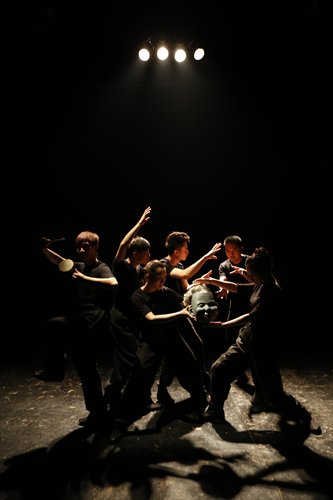HOME >> METRO BEIJING
The physical act
By Li Lin Source:Global Times Published: 2014-4-14 19:53:01

Physical theater draws upon the traditions of mime and masking. Photo: Courtesy of Theatre Santuoqi
Shakespeare's masterpieces are famous for their eloquent speeches. But imagine a classic play like Romeo and Juliet performed using emotive movements rather than verbal delivery.Theatre Santuoqi is a Beijing-based troupe that focuses on "physical theater," which uses exaggerated bodily movements and gestures to express abstract emotions. The troupe is preparing to stage a new edition of Romeo and Juliet, which they originally adapted in 2008 to commemorate the 444th anniversary of Shakespeare's birth. In June of this year, the play will be staged again in Beijing - with even more lines replaced by physical movements, said Zhao Miao, the head of Theatre Santuoqi.
"For example, in ordinary plays, if an actor wants to express sadness, he or she may cry or assume a sorrowful look, but our actors may be on all fours, crawling slowly with a quiver," said Zhao, "Without any facial expression or words, the physical movements themselves can convey to the audience the feelings of sadness and depression." In some performances Zhao and his actors even wear masks to help themselves and the audience focus more intently on the physicality of their acting.
"They're called neutral masks and they are used as a tool to train physical theater actors," said Benjamin Teare, a 25-year-old theater teacher from the UK who studied at L'École Internationale de Théâtre Jacques Lecoq. The very first neutral masks had been commissioned by Lecoq, a famous French actor and mime, to facilitate a state of openness in the students that he taught.
Starting on April 16, as part of the small community theater groups season at the National Theater of China, Theatre Santuoqi will stage one of their most popular plays, Aquatic, which is adapted from a tale from Strange Stories from a Chinese Studio by Pu Songling, a writer of the Qing Dynasty (1644-1911). The play, about the unlikely friendship between a water ghost and a fisherman, integrates aspects of Nuo, a traditional Chinese mask theatre popular in southern China. Nuo, which dates back to primitive times, also features few lines and much miming.
Even though all the actors in Aquatic wear masks, the characters' emotions are plain to see. For example, there are many drinking scenes where the old fisherman passes his wine gourd to the water ghost. At their first meeting, the ghost's movements are swift, he grasps the gourd lightly, guzzles from it and cavorts delightedly - but after a scene in which he mourns the people he has killed, he clutches the vessel tightly and his drinking movements are heavy and slow.
Physical theater first made its way to Asia in the early 2000s, but only started becoming popular in China after 2008. For his part, Teare now leads an informal theater group in Beijing as part of his efforts to promote physical theater and cultivate this sub-specialty of acting in China. In Shanghai, Hong Kong and Beijing, he told Metropolitan, he has found both Chinese students and audience members to be very engaged and hungry to learn more about this new type of stagecraft.
Unlike Santuoqi, Teare said he has had "enough" of Shakespeare. "When we talk about theater, there is always Shakespeare," said Teare. "We need something modern and new." Teare writes all of his own scripts - often in collaboration with the actors; in fact, most of their performances are open workshops instead of formal performances.
"I provoke people to produce their own plays through their personal experiences instead of directing them," said Teare. "Through physical theater, which I prefer to call 'creative theater,' there is always the birth of new ideas, and the play is never the final product."
Posted in: Metro Beijing